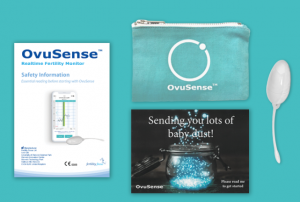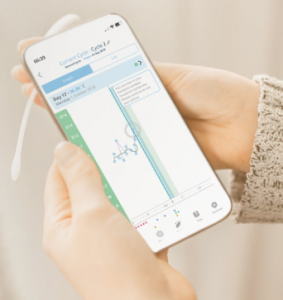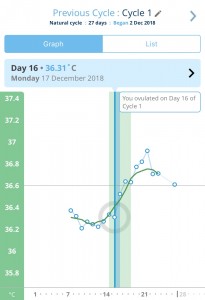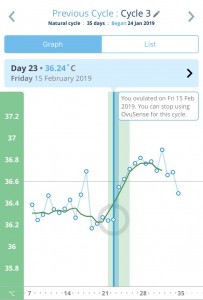During the last four years, something I’ve never been 100% certain of is whether or not I’m actually ovulating. We started trying for a second baby in 2015 and I duly bought and used ovulation sticks, given that they worked like a dream when we conceived our daughter. However second time round I found them to be increasingly unreliable. I seemed to get conflicting information from them, either nothing each month or several peak days. This meant I’d start using them really early to try and catch the right day, which ultimately meant spending loads of money. I stopped using them after a year and aside from a scan with a private consultant in 2016 which showed I had ovulated at the time, bar this confirmation I had no idea what was going on in there every month (hellooooo, anything?!) Because of this and because I simply wasn’t getting pregnant, I felt I could do with some help in this department. So towards the end of last year I found myself looking at devices I could buy, that would help me pinpoint ovulation.
There are quite a few products on the market now that claim to be able to do this. There’s the Ava Bracelet, the Lotus Monitor and Ovusense to name a few contenders. I initially researched the Ava Bracelet, which is is a watch-like device worn at night that reads your resting temperature, but for £249 it doesn’t come cheap. I remember texting my husband something along the lines of, ‘Don’t buy me any birthday/Xmas presents this year, I want this!’ He replied saying, ‘Can’t we find something cheaper?!’ I parked the idea but soon after, Ovusense started following me on Instagram and yes, I got sucked in by their clever tactic. I researched them and felt for £199, that they were a more reasonable price. Also their key sales pitch is that the device is worn internally, so reads your core body temperature rather than your resting pulse rate and because of this, it is 99% accurate in detecting ovulation. Impressive.
On the device itself, you don’t wear it during your period but can start once that’s finished. You wear it at night (You need to have rested for roughly six hours to get a reading) You download the data onto your phone the next morning (for some phones you might need a separate ‘reader’ device) and it uploads your temperature to the chart on your phone APP. From this it can predict your fertile window, which it shows via a coloured area on your chart, and it updates this information regularly during your cycle. After a few days use post-period it can (hopefully) predict the onset of ovulation – the chart changes colour – and a few days after you ovulate it pinpoints the date as to when this happened. How it works exactly is explained here.
I spent a good few days researching and reading up, I found two reviews on You Tube by the same Vlogger on the Ava Bracelet and Ovusense which I found really insightful. I also contacted the brand via Instagram with some questions, which they answered helpfully. I bought and received the device early December 2018. It was pretty easy to set up, you just download the APP onto your phone, connect to the device and away you go. I’ve used Ovusense for eight months now and below I’ve highlighted my pro’s and con’s for you.
Pros:
- The sensor is priced at £199 with a 12 months subscription (you have it for a year then get a new device/another subscription) however via their website and Instagram page they have regular discounts. So when I bought mine, my total cost was actually £149, which is good value I think.
- In my first month of use it picked up ovulation for me, which was fantastic and it’s flagged that I ovulate about 3/4 days later than I had thought. Below is my chart. Each small circle is a logged temperature reading and where the solid blue line is, is where it confirmed ovulation, wahoo!
- I’ve been able to see the classic temperature dip then spike that happens, for some women, pre and post ovulation. I’ve read so many websites on this topic, people have tried to explain this to me, but I’ve never really understood. I’m a visual person, I need to see things written down or drawn, the simpleton that I am. And because of seeing this dip and rise in my temperatures, I’ve learnt to recognise my own pattern and work out for myself when ovulation might happen. It’s given me a huge amount of confidence towards this process.
- Seeing I am ovulating each month means that I know that this bit is definitely happening, clearly it’s all then down to the egg quality and the whole, sperm-meets-egg bit. Damn it.
- In using the sensor, the charts have shown me the effect alcohol has on my temperatures. My husband and I went to Lisbon in February and were drinking every day. If you look at my chart below and see the temperatures before the blue solid line, you can see how erratic they are! Also this particular cycle was much longer, I didn’t ovulate until day 21 whereas I tend to ovulate on day 16/18. And another cycle where I had a drink around ovulation meant my temperature spiked, which then skewed my ovulation date. This has been really interesting to see and has made me think about when and if to drink at certain times during my cycle.
- Because I’m now confident in knowing when I might ovulate, I’ve been able to use my device alongside our current fertility treatment plan. I have to start taking medication the day I ovulate (there or thereabouts) and using Ovusense means I know exactly when this.
- Ovusense is great for women who have PCOS, which can mean you have irregular and long cycles. The sensor has no cut-off point i.e. you can just keep using it until it hopefully picks up ovulation for you.
- Despite concerns on the continued use (there are many questions on this over in the Facebook group), it’s completely hygienic and is made from medical grade silicone. You clean it with warm water and soap, nothing else.
- To date I’ve dealt with both Caroline and Kate at Ovusense who have both been incredibly supportive and helpful.
- You do get the option of a Skype call with a Fertility Nurse after three months use. This is something we haven’t taken up yet as we haven’t felt the need to, but is a great option for those starting out.
- This is both a pro and a con really. There is a Facebook Group you can join and I did find this useful at first. I got help reading my charts, I read other posts with similar stories to mine and I looked at charts that got positive outcomes, however I started to find it a little too full on. There are often regular pregnancy updates which obviously are meant to be positive, but I found I was reacting negatively to these and I found I was incessantly looking at charts with the pregnancy outcomes, so I have chosen to mute it for the time being. I think these things you either love or hate.
Cons:
- It took me a while to get my head around the fact that you pay for the sensor, have it for a year, then you buy a new one. So you essentially have an annual subscription which you renew. It took a fair bit of too’ing and fro’ing on email with Caroline at Ovusense (who was very helpful) to explain this, so this just perhaps needs to be clearer on the website. Regarding renewal costs I’ve checked with them and when your year is up, you pay £22 for a new device (the cost covers handling, processing & shipping) Then you sign up again (scroll down the web page to subscriptions) either for a monthly or annual subscription. I’m told you get a 25% discount if you are a returning customer and sign up annually, which is pretty damn good.
- You wear the sensor at night which I didn’t find comfortable at first, however it’s now something I’m used to (I use a Moooncup and it’s not massively dissimilar). You also need to remember to take it out when you go to the toilet and again this can take some getting used to and is a bit fiddly! If you damage or lose your device they can send you a replacement for £55.
- I couldn’t find any clear instructions on how to interpret my chart when I got started. I got incredibly confused and had to contact Ovusense for help. Kate helped me over email and gave me instructions and information which was super helpful. However, actually in writing this post I’ve realised that this is covered here, so again maybe this needs to be a little clearer on the website.
- I have just completed a medicated cycle where I had to do an injection to make me ovulate. Once I’ve done the injection I ovulate 24-48 hours after, so I know this will have happened on a certain day, however Ovusense has picked up ovulation on a different day (it’s about three days out). In fairness to the device I had only been using it a few days before I had to do the injection, which means it perhaps hadn’t seen a pattern. In doing these medicated cycles I know that the medication skews my temperature readings slightly, which means my chart is probably a bit off for this cycle. This is just something to be aware of if you are doing anything similar.
- The APP is great but could still be better. Not all medications (obviously I appreciate there are thousands) are there and it’s not obvious how you can add any missing ones. It’s a bit of a laborious three step process to add an event, it would be good to have month dates on the chart and it would be great if you could overlay previous charts on top of each other to see patterns. Minor things really.
Ultimately however, pro’s and con’s aside, I think Ovusense is bloody brilliant. It’s something I’ve recommended to quite a few ladies now and at least two have purchased it since. It’s given me such newfound confidence in my body, during a time when I’ve lost confidence because I have felt at times like my body is failing me. I would honestly recommend this to any woman, either starting out on their fertility journey (urgh, I know, what other word to use instead of journey though?!) or to someone like me who was a few years down the line with it all or even to someone who simply wanted to get to grips with their monthly cycle. Hand on heart, it’s a fantastic device and something I wish I had had years ago.
First two images taken with permission from the Ovusense website.





